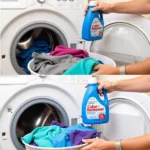Toothpaste tubes often have a colored square or rectangle on the back, near the crimped end. These seemingly insignificant marks have sparked curiosity and even urban legends. So, what do the colors on the back of toothpaste mean? Contrary to some popular myths, they don’t reveal the ingredients or the health benefits of the toothpaste. Instead, they play a crucial role in the manufacturing process.
Decoding the Toothpaste Tube Colors
The colored blocks, often called “eye marks,” are primarily used by sensors in the manufacturing process. These sensors detect the marks and signal the machinery to cut and fold the tube correctly, ensuring proper sealing and packaging. The colors themselves don’t have a specific meaning related to the toothpaste’s formulation. They are chosen for contrast against the tube’s background color, making them easily detectable by the sensors. This ensures efficiency and consistency in the production line.
Why Different Colors?
The specific color used doesn’t indicate anything about the toothpaste itself. Manufacturers choose colors that provide the best contrast with the tube’s design. For example, a black mark might be used on a white tube, while a green mark might be used on a red tube. The goal is simply to make the mark easily recognizable by the optical sensors. The variety of colors solely depends on the packaging design and the sensor’s ability to detect the contrast. Similar to how what do the colors mean on the back of toothpaste, these marks aid in the manufacturing process.
Dispelling the Myths
Several myths surround the meaning of these color codes. Some claim they indicate the proportion of natural versus synthetic ingredients or the level of abrasiveness. Others suggest they represent different types of toothpaste, such as whitening or tartar control. These claims are simply not true. The colors are purely for manufacturing purposes. Understanding what does the color of the toothpaste mean can help dispel these misconceptions.
The Real Significance: Manufacturing Efficiency
The true meaning of these colored marks lies in their contribution to efficient and automated manufacturing. Imagine a production line producing thousands of toothpaste tubes per hour. The eye marks enable precise cutting, folding, and sealing, ensuring each tube is consistently packaged and ready for distribution. This automated process reduces errors, minimizes waste, and keeps production costs down.
How Does it Work?
The process begins with a continuous tube of printed toothpaste packaging material. As the tube moves along the production line, the sensor detects the eye mark. This triggers the machinery to cut the tube at the correct length and initiate the folding and sealing process. The precise positioning ensured by the eye mark prevents leakage and ensures the integrity of the toothpaste tube. Thinking about what do the color codes mean on toothpaste in this way reveals their true purpose.
What the Color Doesn’t Tell You
While the color mark plays a vital role in manufacturing, it doesn’t provide information about the toothpaste’s ingredients or properties. For that, you need to look at the product label. The label will list the active ingredients, such as fluoride for cavity protection, and any other additives, such as whitening agents or desensitizing ingredients. Understanding what do the colors of toothpaste mean requires separating fact from fiction. You can further explore the intriguing world of colors with resources like what does eye color say about you.
“The color marks are purely functional for the manufacturing process,” says Dr. Emily Carter, a leading chemical engineer specializing in consumer product packaging. “They have no bearing on the toothpaste’s formulation or effectiveness.”
Conclusion
In conclusion, the colored marks on the back of toothpaste tubes are not secret codes revealing hidden information. They are essential markers used in automated manufacturing to ensure accurate cutting, folding, and sealing of the tubes. So, the next time you see these colorful rectangles, remember their practical purpose and don’t fall prey to the myths surrounding them. The colors on the back of toothpaste mean simply a mark for the machinery, allowing for efficient and consistent production.
FAQs
- Do the colors indicate the type of toothpaste? No, the colors are for manufacturing purposes only.
- What do the colors mean? They signal the machinery to cut and fold the tube.
- Are black marks for natural toothpaste? No, the color choice is based on contrast with the tube.
- Do the colors indicate the level of fluoride? No, check the label for ingredient information.
- Why are there different colors? Different colors provide better contrast on different tube designs.
- Are there hidden messages in the colors? No, the colors are solely for manufacturing efficiency.
- Where can I find accurate information about the toothpaste ingredients? The product label provides a complete list of ingredients.
Have more questions?
Here are some other topics that might interest you:
- How is toothpaste made?
- What are the different types of toothpaste?
- What are the benefits of using fluoride toothpaste?
Need further assistance? Contact us at Phone Number: 0373298888, Email: [email protected] or visit us at 86 Cau Giay, Hanoi. Our customer service team is available 24/7.

